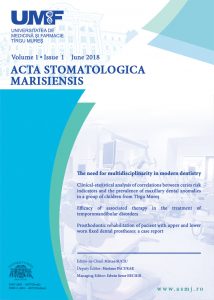Current scientific research has focused on the incorporation of lasers as part of the therapy of periodontal disease. It was proved that the wavelength of different types of units might have a positive effect on both soft and hard tissues healing process consecutive periodontal treatment. Periodontal disease is a multifactorial condition characterized by a microbial etiology and also a host inflammatory component. The contribution of lasers to periodontal health is determined by their antimicrobial, debridement capacity and biostimulation effect [1-3]. The lasers were introduced in periodontology more than 50 years ago, based on the evidence that wounds heal more quickly after irradiation with low-intensity lasers, a process that might be influenced by the stimulation of growth factors. High-intensity lasers were used as part of the nonsurgical periodontal procedures, in comparison with the conventional therapy for cement and soft tissue debridement, especially in order to reduce dentinal hypersensitivity [4]. Laser light has three main characteristics: is monochromatic, directional and coherent. It can be delivered to a tissue area as continuous wave, running pulse mode or gated-pulse mode. The action of lasers on hard and soft dental tissues as well as microorganisms is influenced by the absorption of the laser by tissue chromophore as apatite minerals, water or pigmented substances found at the targeted site [5-7]. Soft tissue lasers proved to give good results in bacterial reduction and coagulation, with erbium group showing a bactericidal effect on Porphyromonas gingivalis and Aggregatibacter actinomycetem comitans. The aim of our study was to evaluate the effectiveness of an Er:YAG laser used during scaling and root planning. It will be compared with the conventional periodontal debridement methods, represented by sonic, ultrasonic and manual instruments and based on images obtained with the scanning electron microscopy, we intend to measure the in vitro effects of Er:YAG laser on the root cement.
Efficacy of periodontal debridement using an Erbium YAG laser: A scanning electron microscopic study
1 Faculty of Dental Medicine, University of Medicine and Pharmacy of Tirgu Mures, Romania
2 Postgraduate student, Faculty of Dental Medicine, University of Medicine and Pharmacy of Tirgu Mures, Romania

Comments are closed.